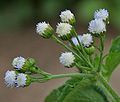- Ageratum conyzoides
-
"Goatweed" redirects here. For the butterfly, see Anaeini.
Ageratum conyzoides 
Scientific classification Kingdom: Plantae (unranked): Angiosperms (unranked): Eudicots (unranked): Asterids Order: Asterales Family: Asteraceae Tribe: Eupatorieae Genus: Ageratum Species: A. conyzoides Binomial name Ageratum conyzoides
L.Ageratum conyzoides (Billygoat-weed, Chick weed, Goatweed, Whiteweed; Ageratum conycoides L., Ageratum obtusifolium Lam., Cacalia mentrasto Vell.) is native to Tropical America, especially Brazil. Herb 0.5–1 m. high, with ovate leaves 2–6 cm long, and flowers are white to mauve.[1]
In Vietnamese, the plant is called cứt lợn (Pig Feces) due to its growth in dirty areas.[2]
Contents
Uses
As a medicinal plant, Ageratum conyzoides has limited uses due to its toxicity. It is also an insecticide and nematicide.[3]
Toxicity
Ingesting A. conyzoides can cause liver lesions and tumors.[4][5] The plant contains the pyrrolizidine alkaloids lycopsamine and echinatine.[6]
Weed risk
A. conyzoides is prone to becoming a rampant environmental weed when grown outside of its natural range. It is an invasive weed in Africa, Australia, Southeast Asia and USA.[7][8] It is considered a moderate weed of rice cultivation in Asia. [9]
References
- ^ NSW Flora Online, Ageratum conyzoides
- ^ http://vi.wikipedia.org/wiki/C%E1%BB%A9t_l%E1%BB%A3n
- ^ Ming, L.C. (1999) Ageratum conyzoides: A tropical source of medicinal and agricultural products. p. 469–473. In: J. Janick (ed.), Perspectives on new crops and new uses. ASHS Press, Alexandria, VA.
- ^ Sani, Y., Bahri, S., "Pathological changes in liver due to the toxicity of Ageratum conyzoides", Penyakit Hewan (Indonesia), 1994, v. 26(48) p. 64-70 [1]
- ^ Fu, P.P., Yang, Y.C., Xia, Q., Chou, M.C., Cui, Y.Y., Lin G., "Pyrrolizidine alkaloids-tumorigenic components in Chinese herbal medicines and dietary supplements", Journal of Food and Drug Analysis, Vol. 10, No. 4, 2002, pp. 198-211[2]
- ^ Molyneux, R., "Hepatatoxic alkaloids in Afghan and Ethioipian cereal grains: a need for rapid screening methods", AOAC Pacific Northwest Section, Annual Meeting, June 2009.[3]
- ^ Global Compendium of Weeds, Ageratum conyzoides (Asteraceae)
- ^ Alan S. Weakley (April 2008). "Flora of the Carolinas, Virginia, and Georgia, and Surrounding Areas". http://www.herbarium.unc.edu/flora.htm.
- ^ Caton, B. P.; M. Mortimer, J. E. Hill (2004). A practical field guide to weeds of rice in Asia. International Rice Research Institute. pp. 16–17. http://books.google.co.uk/books?id=ver3qCQF9EEC&printsec=frontcover&dq=field+guide&hl=en&ei=DjywTLzQGYiBOvyFgIwG&sa=X&oi=book_result&ct=result&resnum=6&ved=0CEYQ6AEwBTgK#v=onepage&q&f=false.
External links
- Plants For Future: Ageratum conyzoides
- Tropical Plant Database: Ageratum conyzoides
- (Portuguese) Ageratum conyzoides photos
Gallery

This Eupatorieae article is a stub. You can help Wikipedia by expanding it.




